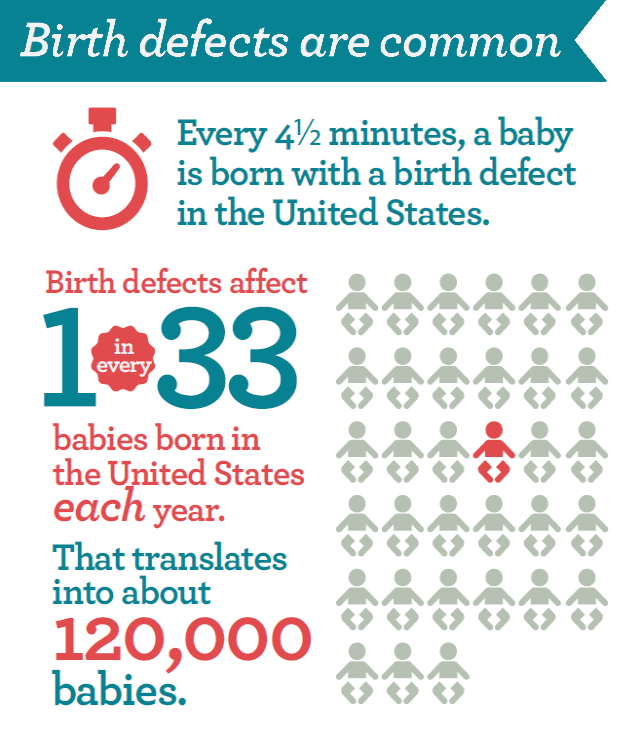What Are My Chances of Having a Baby With Birth Defects
Birth defects are common, costly, and critical conditions that affect 1 in every 33 babies born in the United States each year.1 Read more about what we have learned about birth defects and how women can improve their chances of having a baby born without a birth defect.
Birth Defects Are Common

Every 4 ½ minutes, a baby is born with a birth defect in the United States. That means nearly 120,000 babies are affected by birth defects each year.1
Birth defects are structural changes present at birth that can affect almost any part or parts of the body (e.g., heart, brain, foot). They may affect how the body looks, works, or both. Birth defects can vary from mild to severe. The well-being of each child affected with a birth defect depends mostly on which organ or body part is involved and how much it is affected. Depending on the severity of the defect and what body part is affected, the expected lifespan of a person with a birth defect may or may not be affected.
Identifying Birth Defects
A birth defect can be found before birth, at birth, or any time after birth. Most birth defects are found within the first year of life. Some birth defects (such as cleft lip) are easy to see, but others (such as heart defects or hearing loss) are found using special tests, such as echocardiograms (an ultrasound picture of the heart), x-rays or hearing tests.
Learn more about diagnosing birth defects »
Causes

Birth defects can occur during any stage of pregnancy. Most birth defects occur in the first 3 months of pregnancy, when the organs of the baby are forming. This is a very important stage of development. However, some birth defects occur later in pregnancy. During the last six months of pregnancy, the tissues and organs continue to grow and develop.
For some birth defects, like fetal alcohol syndrome, we know the cause. But for most birth defects, we don't know what causes them. For most birth defects, we think they are caused by a complex mix of factors. These factors include our genes (information inherited from our parents), our behaviors, and things in the environment. But, we don't fully understand how these factors might work together to cause birth defects.
While we still have more work to do, we have learned a lot about birth defects through past research. For example, some things might increase the chances of having a baby with a birth defect, such as:
- Smoking, drinking alcohol, or taking certain drugs during pregnancy.
- Having certain medical conditions, such as being obese or having uncontrolled diabetes before and during pregnancy.
- Taking certain medications, such as isotretinoin (a drug used to treat severe acne).
- Having someone in your family with a birth defect. To learn more about your risk of having a baby with a birth defect, you can talk with a clinical geneticist or a genetic counselor.
- Having certain infections during pregnancy such as Zika virus and cytomegalovirus.
- Experiencing fever greater than 101oF or having an elevated body temperature due to heat exposure.
- Being an older mother, as the risk of chromosomal abnormalities increases with age.
Having one or more of these risks doesn't mean you'll have a pregnancy affected by a birth defect. Also, women can have a baby born with a birth defect even when they don't have any of these risks. It is important to talk to your doctor about what you can do to lower your risk.
Learn about CDC's research on causes and risk factors »
Prevention

Not all birth defects can be prevented. But, there are things that a woman can do before and during pregnancy to increase her chance of having a healthy baby:
- Be sure to see your healthcare provider regularly and start prenatal care as soon as you think you might be pregnant.
- Get 400 micrograms (mcg) of folic acid every day, starting at least one month before getting pregnant.
- Don't drink alcohol or smoke.
- Talk to a healthcare provider about any medications you are taking or thinking about taking. This includes prescription and over-the-counter medications and dietary or herbal supplements. Don't stop or start taking any type of medication without first talking with a doctor.
- Know how to prevent infections during pregnancy.
- Be proactive in identifying and treating fever when ill or after getting a vaccine. Treat fevers higher than 101oF with Tylenol® (or store brand acetaminophen), and avoid hot tubs, saunas, or other environments that might cause overheating.
- If possible, be sure any medical conditions are under control, before becoming pregnant. Some conditions, such as diabetes, can increase the risk for birth defects.
More tips to prevent birth defects »
Living with a Birth Defect

Babies who have birth defects often need special care and interventions to survive and to thrive developmentally. State birth defects tracking programs provide one way to identify and refer children as early as possible for services they need. Early intervention is vital to improving outcomes for these babies. If your child has a birth defect, you should ask his or her doctor about local resources and treatment. Geneticists, genetic counselors, and other specialists are another resource.
Find more information for families who have a child with a birth defect »
References
- Centers for Disease Control and Prevention. Update on Overall Prevalence of Major Birth Defects–Atlanta, Georgia, 1978-2005. MMWR Morb Mortal Wkly Rep. 2008;57(1):1-5.
What Are My Chances of Having a Baby With Birth Defects
Source: https://www.cdc.gov/ncbddd/birthdefects/facts.html
0 Response to "What Are My Chances of Having a Baby With Birth Defects"
Enregistrer un commentaire